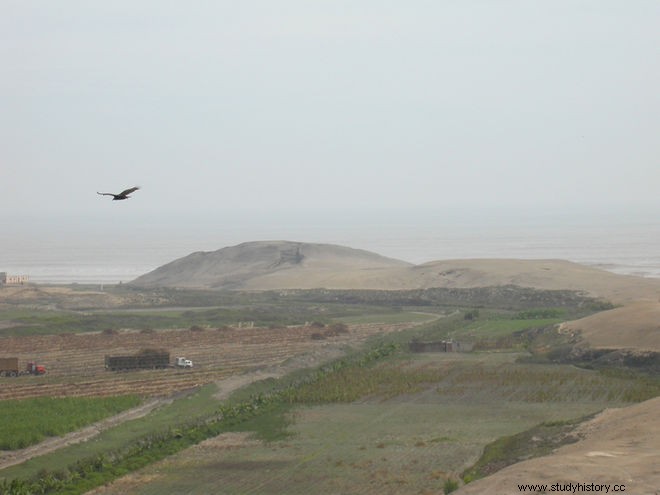 Traces of indigo blue dyes discovered on textile fragments from the sanctuary of Huaca Prieta, north of Trujillo, Peru.
Traces of indigo blue dyes discovered on textile fragments from the sanctuary of Huaca Prieta, north of Trujillo, Peru. BLUE. Were the ancient Peruvians the first to see the world in blue? Archaeologists have indeed just discovered evidence of the use of the oldest indigo dye in the foundations of a vast sanctuary dated 6200 years... That is 1600 years earlier than the Egyptians of Pharaonic times to whom we attributed its oldest use.
 The sanctuary of Huaca Prieta on the northern coast of Peru. © Jeffrey C. Splitstoser
The sanctuary of Huaca Prieta on the northern coast of Peru. © Jeffrey C. Splitstoser
These first traces were found at Huaca Prieta , a ceremonial monument on the northern coast of Peru. According to a recent study published in Science Advance:fragments of fabrics with fibers still impregnated with this blue were buried in the thick layers of sediment of an access ramp leading to the site. Analysis of eight small pieces of Andean cotton (Gossypium barbadense ) revealed traces of indigo blue on the now faded stripes of five of them. They have been revealed using the technique known as high performance liquid phase chromatography (HPLC) which makes it possible to separate molecules present in a mixture. A surprise for Jeffrey Splitstoser, professor of anthropology at George-Washington University (United States), author of this study on the discovery of the use of organic compounds from Indigofera spp .*, a dye plant from South America.
"Indigo remained until the end of the 19th century the queen of dyes and it was not until 1883 that the German chemist Adolf von Baeyer succeeded in determining the chemical structure of indigotin, its main dye “, writes Dominique Cardon, director of research emeritus at the CNRS, one of the most eminent specialists in these questions. A color at the origin of a planetary success. The one encountered by the fabrics of Nîmes (denim ) and Genoa (jeans )…
The magic of indigo
In his book "The world of natural dyes "*, Dominique Cardon returns to the mysteries of indigo:"Indigo, a dark blue coloring matter, differs from all other dyes. Firstly because it does not exist as such in the many so-called "indigo" plants, but is formed from the juice of these crushed plants or put to macerate in water, and by the action oxygen from the air. Secondly, because it is insoluble in its blue form, it cannot impregnate textile fibers and attach themselves to them. To dye with indigo, it must be transformed into a different substance, soluble but almost colorless, which soaks the fibers. It is only when taken out of the liquid and exposed to the air, that the textiles turn blue visibly... as if by magic".
Read: "The world of natural dyes ", Belin edition, 2014.
